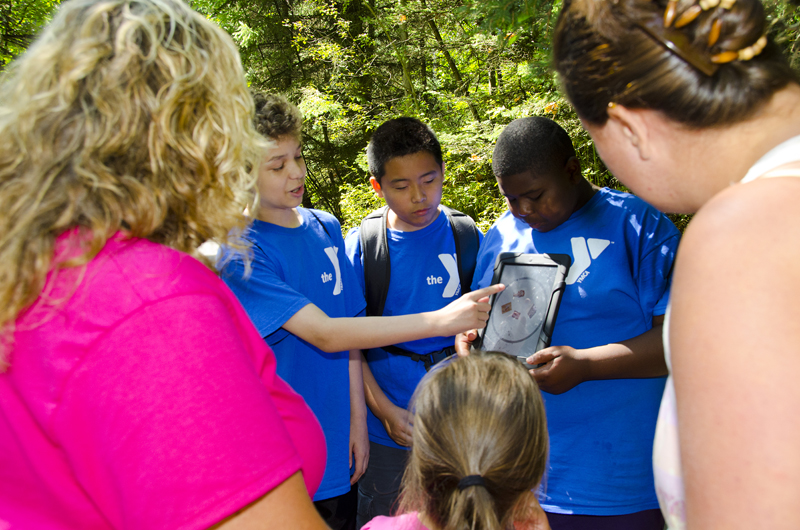Program Profiles
How do successful afterschool STEM programs do it?
These innovative afterschool programs offer impactful STEM programming to diverse populations. Read on to hear their advice for success and to learn about their program structure, evaluation results and partnership models.
ZooCrew
For more than 110 years, Woodland Park Zoo has served as a cherished community resource and a unique urban oasis. Today, our mission is to “save wildlife and inspire everyone to make conservation a prioirity in their lives.” We fulfill our mission through three main areas of activity: excellent animal care, investment in field conservation, and education programs on the ground and in the community. With more than 1 million visitors each year, Woodland Park Zoo has tremendous capacity to engage the community in our mission.
ZooCrew was a middle school outreach program from the Woodland Park Zoo that empowered middle school youth to become conservation and community leaders by providing engaging experiences that inspire them to learn, care, and act.
Approximately 180 middle school students at five sites participated in ZooCrew each year. ZooCrew served middle school students from underserved communities who are underrepresented in STEM careers. To serve these students, the zoo partnered with out-of-school service providers selected based on their established record working with low-income and minority students.
For example, at Aki Kurose Middle School, one of the former ZooCrew sites, 83 percent of students qualify for the federal free and reduced-price lunch program, 20 percent are English language learners, and 64 percent achieved less than 60 percent proficiency in Measure of Student Progress (MSP) in science.

Our summer program served more than 60 7 th and 8th graders through daily interactive science lessons in a six week academic and enrichment program in partnership with the YMCA. During the school year we ran the program at five middle schools in the Seattle area, serving 10 to 15 middle school students per site, through weekly two-hour programs. Programs were 9-11 weeks long with three programs offered each year at each site, fall, winter and spring quarters.
The ZooCrew model used a three-tiered educational approach to support skill development in problem-solving and science inquiry.
Activities built on each other over the course of the quarter and culminated in a visit to the zoo and an end of quarter event at the school. ZooCrew participants received free zoo passes at the end of each quarter so that they could bring family or friends to the zoo and share what they learned.
Our program goals were as follows:
Woodland Park Zoo is one of only a hand full of zoos with full time professional evaluators on staff. When the ZooCrew program was operational, the zoo’s Audience Research Supervisor and Coordinator worked closely with the Youth Programs team to develop and implement an assessment plan for the ZooCrew program. The program's evaluation plan included a variety of formal and informal assessment methods designed specifically the ZooCrew to address the diverse learning styles and language skills of program participants.
Through ZooCrew, Woodland Park Zoo partnered with out-of-school program providers to engage low-income and minority middle school students in hands-on STEM learning. Partners included YMCA’s Community Learning Center’s at Madison middle school; Seattle Parks and Recreation at Mercer, Washington, and Eckstein middle schools; and the Highline School District STEM Department and Community Schools Collaboration at Chinook Middle School. Partners were selected due to their alignment with target audiences (low-income, minority), their desire and commitment to partner with the zoo, and their interest in integrating STEM and/or conservation elements into their programming.
Major funding sources included the Dean Witter Foundation, Raikes Foundation, the RealNetworks Foundation, and the City of Seattle’s Families and Education Levy.
What feature of your program do you think has been most crucial for success?
The ZooCrew program model was founded on the idea that every student should have opportunities to become empowered community leaders. ZooCrew blended the interrelated domains of science, technology, engineering and math in the form of project-based learning. This allowed youth to approach real-world problems through informed decision making—crucial skills for success in the 21st century.
Mentorship was also a strong component of the ZooCrew program. As youth carried out their projects, they were matched with zoo staff who could give them professional guidance. These relationships underscored the importance of STEM subjects in many careers, replacing the image of a white-coated scientist with that of a veterinarian, zookeeper, conservation biologist, events planner, photographer or Web designer.
What were some of the challenges the program faced in its early stages?
ZooCrew was an active partnership between Woodland Park Zoo and out-of-school providers. New partnerships can be a challenge, and in the pilot year we worked with three very distinct partners on this project, each of whom had different needs. We learned the value of clear and on-going communication, and the importance of selecting partners with adequate internal capacity.
We also identified that in order to successfully run an afterschool program in partnership with other youth and community organizations that there needs to be time set aside for staff to have weekly contact with partner staff beyond the allotted time at each program site.
What advice would you have for programs that want to integrate STEM?